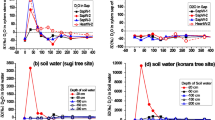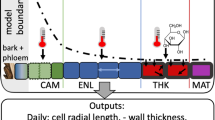Abstract
AN important change which occurs in the wood of most trees as they grow older is the transformation of sapwood into heartwood. This change is associated with the death of the ray and vertical parenchyma cells, and definite modifications to the anatomy of both softwoods and hardwoods1. As a result, heartwood is more difficult to season, is less readily penetrated by preservatives and pulping liquors, and resinous extractives are troublesome.
This is a preview of subscription content, access via your institution
Access options
Similar content being viewed by others
References
Trendelenberg, R. (1939) Das Holz als Rohstof, trans., 131 (Imp. For. Bur., Oxford, 1946).
Schreiner, E. J., Silvae Gen., 7 (4), 122 (1958).
Harris, J. M., New Zealand For. Serv. Tech. Paper, No. 1 (1954).
Lush, J. L., Animal Breeding Plans (Iowa State Coll. Press, Ames, 1937).
Koch, J. E., and Krieg, W., Chemiker Ztg., 15, 140 (1938).
Dadswell, H. E., Fielding, J. M., Nicholls, J. W. P., and Brown, A. G., Tappi, 44, 174 (1961).
Author information
Authors and Affiliations
Rights and permissions
About this article
Cite this article
NICHOLLS, J. Heritability of Heartwood Formation in Pinus radiata D. Don. Nature 207, 320 (1965). https://doi.org/10.1038/207320a0
Issue date:
DOI: https://doi.org/10.1038/207320a0
This article is cited by
-
Distribution, properties and formation of some wood extractives
Wood Science and Technology (1971)
-
Chemical aspects of heartwood formation
Wood Science and Technology (1968)



